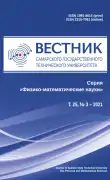Строгое решение задачи о состоянии линейно-упругого изотропного тела под воздействием полиномиальных объемных сил
- Авторы: Пеньков В.Б.1, Левина Л.В.1, Новиков Е.А.1
-
Учреждения:
- Липецкий государственный технический университет
- Выпуск: Том 25, № 3 (2021)
- Страницы: 475-490
- Раздел: Механика деформируемого твердого тела
- URL: https://journals.eco-vector.com/1991-8615/article/view/65278
- DOI: https://doi.org/10.14498/vsgtu1864
- ID: 65278
Цитировать
Полный текст
Аннотация
При решении краевых задач о построении напряженно-деформированного состояния линейно-упругого изотропного тела важным шагом является отыскание внутреннего состояния, порожденного силами, распределенными по занятой телом области. В классическом варианте существует численный способ оценки состояния в любой точке тела, базирующийся на сингулярно-интегральном представлении Чезаро. В варианте консервативных объемных сил возможно выписывание решений в аналитической форме. При произвольных регулярных воздействиях механической и иной физической природы силы потенциальными не являются и подходы Папковича–Нейбера и Аржаных–Слободянского оказываются бессильными. Кроме этого, решение нелинейных задач эластостатики средствами метода возмущений, а также использование при решении задач для исследования многополостных тел алгоритма Шварца приводят к необходимости решения последовательности линейных задач. При этом в обязательном порядке зарождаются фиктивные объемные силы, имеющие, как правило, полиномиальный характер.
Разработанный авторами ранее метод оценки напряженно-деформированного состояния тела, вызванного воздействием полиномиальных объемных сил, представляемых в декартовых координатах, получил развитие. Внутреннее состояние восстанавливается в строгом соответствии с силами, статически воздействующими на односвязное ограниченное линейно-упругое тело. Предложены и описаны эффективный метод построения решения и алгоритм его компьютерной реализации. Продемонстрированы тестовые расчеты. Выполнен анализ состояния шара, находящегося под воздействием суперпозиции объемных сил различного характера при различных соотношениях параметров, подчеркивающих уровень влияния этих факторов. Результаты оформлены графически. Сделаны следующие выводы:
а) обоснована процедура выписывания напряженно-деформированного состояния от объемных сил, представляемых полиномами от декартовых координат;
б) алгоритм реализован в вычислительной системе Mathematica и проведено тестирование на многочленах высокого порядка;
в) проведен анализ квазистатического состояния линейно-упругого изотропного шара, подверженного воздействию сил гравитации и инерции при различных сочетаниях параметров, отвечающих вариантам медленного, быстрого, компенсационного (инерционные силы соразмерны с гравитационными) вращений.
Отмечены перспективы развития нового подхода на класс ограниченных и неограниченных тел, содержащих произвольное число полостей.
Об авторах
Виктор Борисович Пеньков
Липецкий государственный технический университет
Email: vbpenkov@mail.ru
ORCID iD: 0000-0002-6059-1856
SPIN-код: 3720-0060
Scopus Author ID: 56490841400
http://www.mathnet.ru/person49362
доктор физико-математических наук; профессор; каф. общей механики
Россия, 398055, Липецк, ул. Московская, 30Любовь Владимировна Левина
Липецкий государственный технический университет
Email: satalkina_lyubov@mail.ru
ORCID iD: 0000-0002-7441-835X
SPIN-код: 6294-4940
Scopus Author ID: 57201669457
ResearcherId: ABF-3858-2020
http://www.mathnet.ru/person142808
кандидат физико-математических наук; доцент; каф. прикладной математики
Россия, 398055, Липецк, ул. Московская, 30Евгений Александрович Новиков
Липецкий государственный технический университет
Автор, ответственный за переписку.
Email: 89513027802@mail.ru
ORCID iD: 0000-0001-5606-5207
Scopus Author ID: 57208702566
http://www.mathnet.ru/person171353
аспирант; кафедра общей механики
Россия, Россия, 398055, Липецк, ул. Московская, 30Список литературы
- Truesdell C. A First Course in Rational Continuum Mechanics. Vol. 1: General Concepts / Pure and Applied Mathematics. vol. 71. New York, San Francisco, London: Academic Press, 1977. xxiii+280 pp.
- Работнов Ю. Н. Механика деформируемого твердого тела. М.: Наука, 1988. 712 с.
- Лурье А. И. Теория упругости. М.: Наука, 1970. 940 с.
- Мусхелишвили Н. И. Некоторые основные задачи математической теории упругости. М.: Наука, 1966. 707 с.
- Green A. E., Zerna W. Theoretical Elasticity. New York: Dover Publications, 1992. xvi+457 pp.
- Arfken G. B., Weber H. J. Mathematical Methods for Physicists. Amsterdam: Elsiver/Academic Press, 2005. xii+1182 pp.
- Neuber H. Ein neuer Ansatz zur Lösung räumlicher Probleme der Elastizitätstheorie. Der Hohlkegel unter Einzellast als Beispiel // ZAMM, 1934. vol. 14, no. 4. pp. 203–212. https:// doi.org/10.1002/zamm.19340140404.
- Матвеенко В. П., Шевелев Н. А. Аналитическое исследование напряженно-деформированного состояния тел вращения, находящихся под действием массовых сил / Напряженно-деформированное состояние конструкций из упругих и вязкоупругих материалов. Свердловск: УНЦ АН СССР, 1977. С. 54–60.
- Вестяк В. А., Тарлаковский Д. В. Нестационарное осесимметричное деформирование упругого пространства со сферической полостью под действием объемных сил // Вестник Московского университета. Сер. 1. Математика. Механика, 2016. Т. 71, № 4. С. 48–54.
- Шарафутдинов Г. З. Функции комплексного переменного в задачах теории упругости при наличии массовых сил // ПММ, 2009. Т. 73, № 1. С. 69–87.
- Зайцев А. В., Фукалов А. А. Точные аналитические решения задач о равновесии упругих анизотропных тел с центральной и осевой симметрией, находящихся в поле гравитационных сил, и их приложения к задачам геомеханики // Математическое моделирование в естественных науках, 2015. Т. 1. С. 141–144.
- Пикуль В. В. К аномальному деформированию твердых тел // Физическая мезомеханика, 2013. Т. 16, № 2. С. 93–100.
- Козлов В. В. Сила Лоренца и ее обобщения // Нелинейная динам., 2011. Т. 7, № 3. С. 627–634.
- Саталкина Л. В. Метод граничных состояний в задачах теории упругости неоднородных тел и термоупругости: Дис. ... канд. физ.-мат. наук. Липецк, 2010. 108 с.
- Penkov V. B., Novikov E. A., Novikova O. S., Levina L. V. Combining the method of boundary states and the Lindstedt–Poincaré method in geometrically nonlinear elastostatics // J. Phys.: Conf. Ser., 2020. vol. 1479, 012135. https://doi.org/10.1088/1742-6596/1479/1/012135.
- Иванычев Д. А., Новиков Е. А. Решение физически нелинейных задач для изотропных тел методом граничных состояний / Проблемы прочности, пластичности и устойчивости в механике деформируемого твердого тела. Тверь: ТвГТУ, 2021. С. 43–47.
- Penkov V. B., Ivanychev D. A., Levina L. V., Novikov E. A. Using the method of boundary states with perturbations to solve physically nonlinear problems of the theory of elasticity // J. Phys.: Conf. Ser., 2020. vol. 1479, 012134. https://doi.org/10.1088/1742-6596/1479/1/012134.
- Кузьменко В. И., Кузьменко Н. В., Левина Л. В., Пеньков В. Б. Способ решения задач изотропной теории упругости с объемными силами в полиномиальном представлении // ПММ, 2019. Т. 83, № 1. С. 84–94. https://doi.org/10.1134/S0032823519010053.
- Пеньков В. Б., Левина Л. В., Новикова О. С. Аналитическое решение задач эластостатики односвязного тела, нагруженного неконсервативными объемными силами. Теоретическое и алгоритмическое обеспечение // Вестн. Сам. гос. техн. ун-та. Сер. Физ.-мат. науки, 2020. Т. 24, № 1. С. 56–73. https://doi.org/10.14498/vsgtu1711.
- Иванычев Д. А. Метод граничных состояний при решении смешанной задачи теории анизотропной упругости с массовыми силами // Вестн. Томск. гос. ун-та. Матем. и мех., 2021. № 71. С. 63–77. https://doi.org/10.17223/19988621/71/6.
- Пеньков В. Б., Рыбакова М. Р., Саталкина Л. В. Применение алгоритма Шварца к пространственным задачам теории упругости // Вести вузов Черноземья, 2015. № 2 (40). С. 23–31.
Дополнительные файлы







